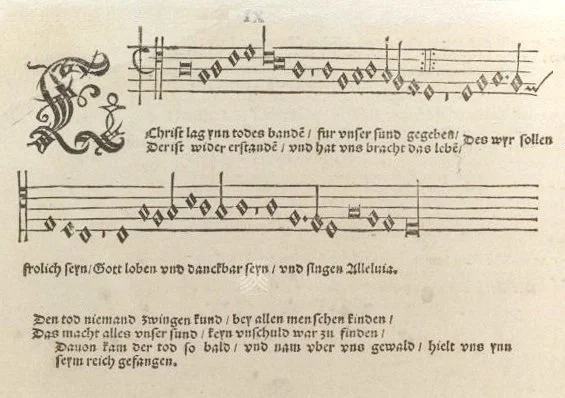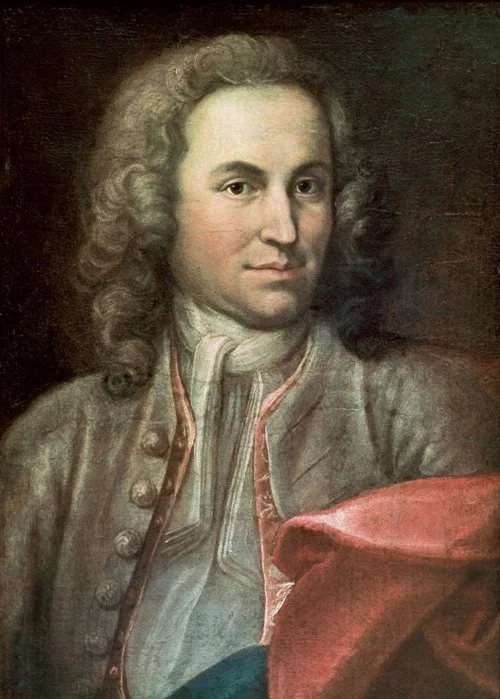Christ Lag in Todes Banden - BWV 4
by David Flaxman
Young Johann Sebastian Bach by Johann Ernst Rentsch the Elder (c. 1715) {{PD-US}}
Recent research suggests, however, that this portrait is not actually of the young Bach!
Johann Sebastian Bach was born in 1685 in Eisenach in what is now Germany. He was the eighth and youngest child of his family, a family in which the predominant trade of the males was that of musician. It was so common for a member of his family to be a well-known musician that the word “Bach” came to be used as a synonym for “musician.” Unfortunately for young Johann Sebastian his mother died when he was only nine, shortly to be followed in death by his father. Bach was sent to live with his much older brother, Johann Christoph.
Christoph was of course a talented musician and he helped develop Bach’s skills as a keyboard player and violinist, but also taught him the inner workings of the organ in the church where he was music director. From an early age, then, Sebastian was steeped in the sacred music of the church and was encouraged to develop expertise in the organ. Throughout his life, Bach would earn supplemental income as an expert in organ construction and as a consultant in the process of acquiring a new organ by a town council or a church.
Possibly also thanks to the early tragedy in his life, the church became an important refuge for him. Unlike other great musicians like Mozart and Beethoven, for whom we cannot say with certainty that they were totally committed to their faith, Bach, from all evidence, was a completely devout Lutheran who came to see as a theme of his life’s work to advance the teachings of Martin Luther and Christianity through his music.
In January 1703, Bach was appointed court musician in the chapel of Duke Johann Ernst III in Weimar. During his seven-month tenure at Weimar, his reputation as a keyboardist spread so much that he was invited to inspect the new organ and give the inaugural recital at the New Church (now Bach Church) in Arnstadt. On August 14, 1703, he became the organist at the New Church. As happened again throughout much of his life, he soon became disenchanted with this job.
So, in 1706 the 21-year-old Bach applied for a post as organist at the Blasius Church in Mühlhausen. As part of his application, he had a cantata performed on Easter, April 24, 1707, which is thought to have been an early version of his Christ lag in Todes Banden (BWV 4). A month later Bach's application was accepted and he took up the post in July; the position included significantly higher remuneration, improved conditions, and a better choir. Four months after arriving at Mühlhausen, Bach married Maria Barbara Bach, his second cousin, in 1706. She would die in 1720 while Bach was then working on Köthen for Prince Leopold, leading to his marriage a year later to Anna Magdalena.
When Bach composed this early cantata, it was common for a cantata to take the form of a chorale partita. A chorale partita is a keyboard work that is based upon a chorale theme, usually a theme that originated in a Gregorian chant. In BWV 4 that chorale theme comes from a hymn by Martin Luther of the same name—“Christ lag in Todes Banden” (Christ lay in death’s bonds). Luther’s hymn is based upon the 12th-century Easter hymn "Christ ist erstanden" (Christ is risen). This chorale tune would have been familiar to Bach's congregations.
We hear the hymn in all its glory in the closing chorale, beautifully harmonized by Bach. The first verse “Wir essen und leben wohl im rechten Osterfladen” (“We eat and live well/In [Christ, the] proper paschal/Easter flatbread”) demonstrates the Easter origins of Luther’s hymn. Throughout the work the hymn shows up often in augmentation (long note values) in one voice while the other voices are singing fugal themes. While Bach’s cantata style would evolve in his later years in Leipzig where he undertook a multi-year project to create a new cantata each week, this approach of incorporating a chorale theme into his music would never completely disappear. Even in his great Passions, St. Matthew and St. John, chorales based on Luther’s or other hymns, would play a central role in Bach’s communication of the central themes of his texts. Luther believed strongly that music was an important part of communicating his message to a congregation and began the practice of incorporating hymns in the vernacular (i.e, German rather than Latin) into services and encouraging the congregations to learn and sing the hymns. In his service to Luther and the church, Bach took this practice to ever greater heights, leaving us with a treasure trove of cantatas like BWV 4, his two great Passions, and of course his monumental B Minor Mass.
Hear Christ lag in Todes Banden for yourself at the City Choir of Washington’s June 1 concert!


